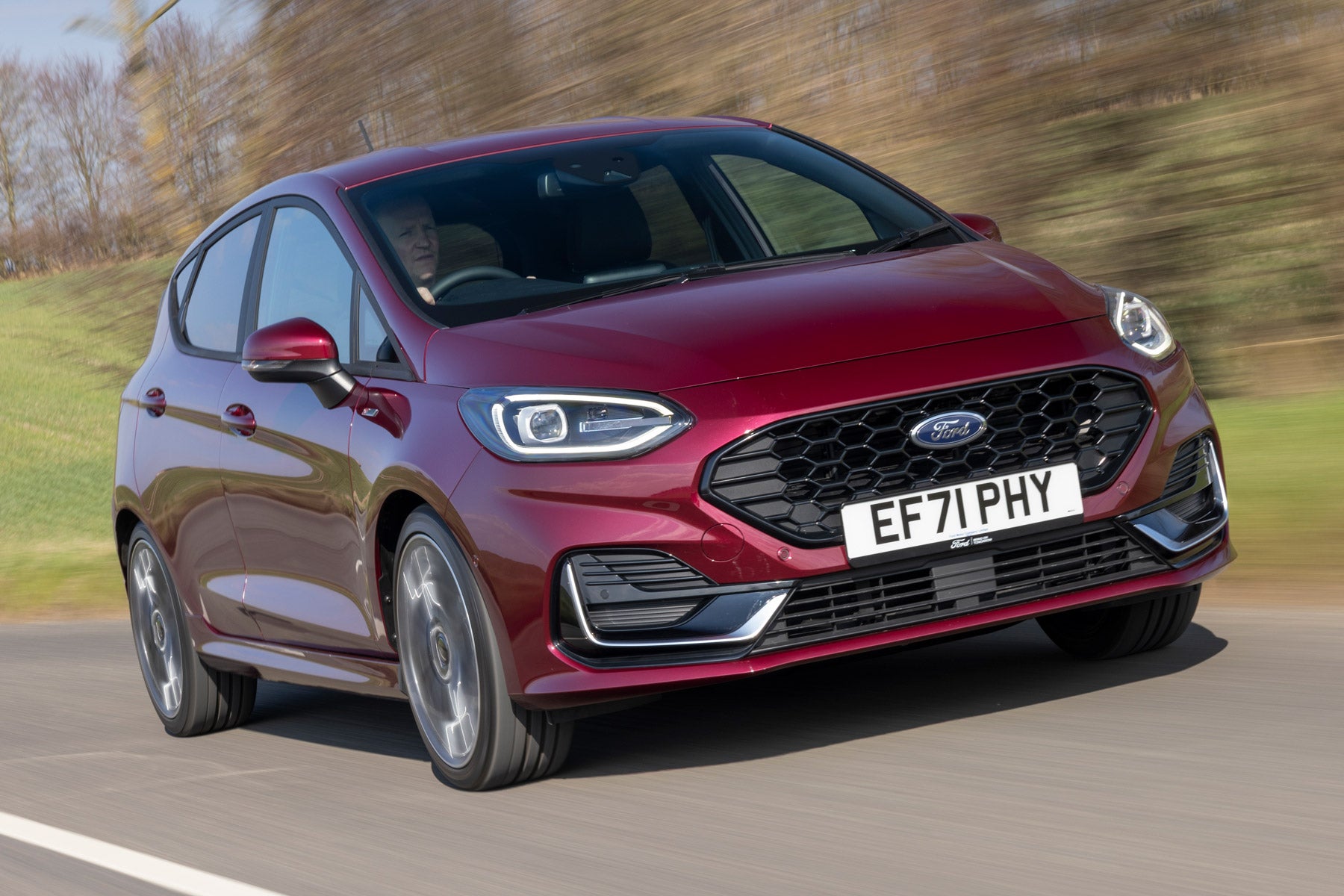Ford Fiesta Review 2025: Price, specs & boot space
Written by Andrew Brady
Quick overview
Pros
- Comfortable, well made and roomy cabin
- Impressive levels of refinement coupled to great driving fun
- Wide range of engines and trims to pick from
Cons
- Some models are expensive
- 1.1-litre petrol engine now feeling outdated
- Will soon be removed from sale
Overall verdict on the Ford Fiesta
"We're going to really miss the Ford Fiesta now that it has been dropped. It remains one of the best little cars you can buy today, with low running costs, a stylish interior and excellent value for money. It's also one of the most enjoyable small hatchbacks to drive, thanks to its eager handling and sprightly turbocharged petrol engines."
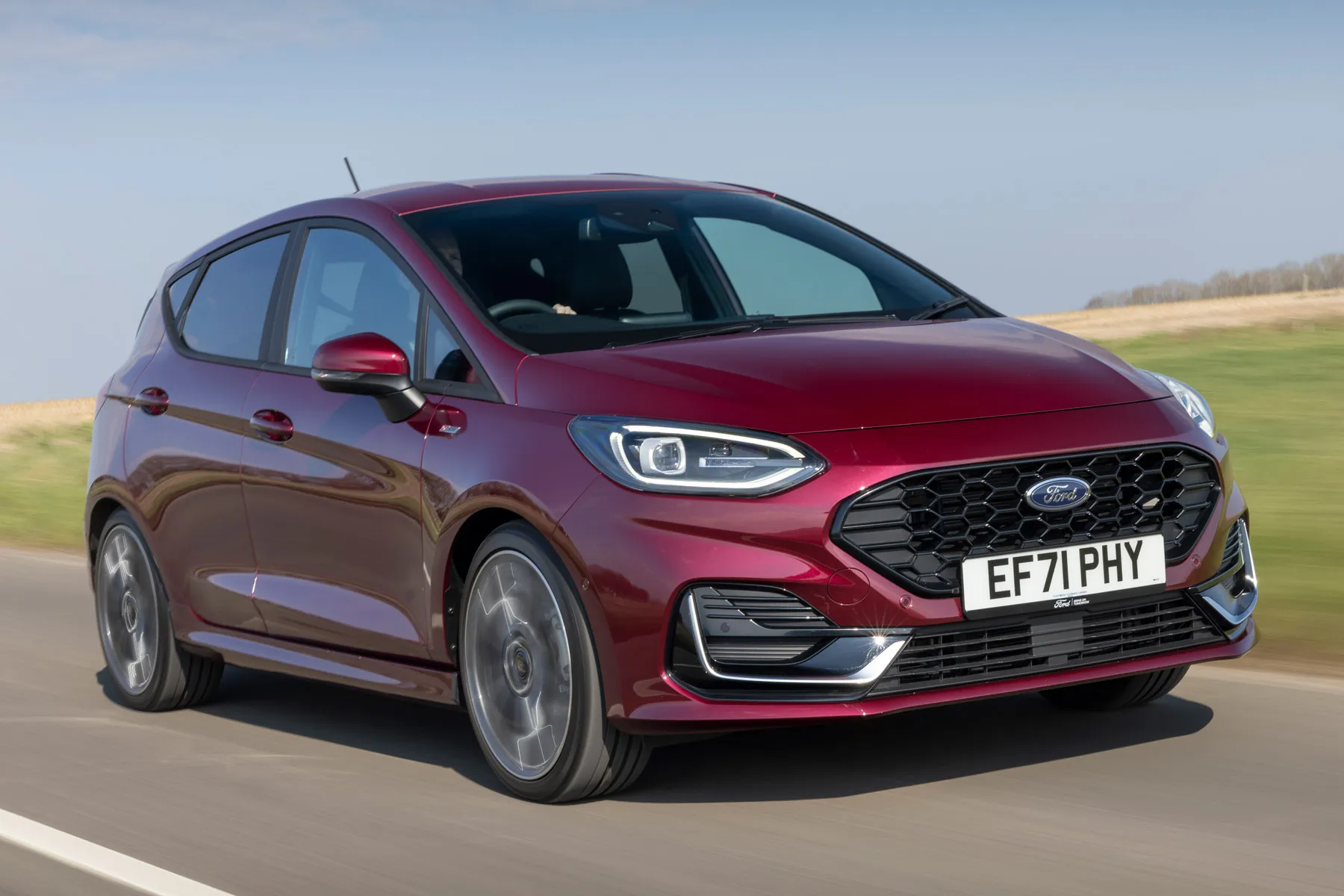
The final generation of Ford Fiesta went on sale in 2017 and remains one of the best small cars you can buy today. Its incredible popularity is largely due to the many different personalities it offers - including the hot hatch Ford Fiesta ST and off-roady Ford Fiesta Active versions for even more variation on the theme.
Sticking to the main Fiesta range, it comes in three- and five-door hatchback forms to lock horns with the Vauxhall Corsa and Volkswagen Polo, as well as the Hyundai i20, Renault Clio, SEAT Ibiza, Skoda Fabia and Toyota Yaris. That strength and depth of competition means the Fiesta could only ever be on top form if it wanted to stay as one of the best cars in its class.
To achieve that aim, the Ford Fiesta offers a more refined drive than its predecessor to tackle the Polo head-on for comfort. It also serves up more grip and cornering prowess to keep the SEAT Ibiza at bay, while more luxurious versions even have the ability to give the MINI and Audi A1 a run for their considerable money.
Doing all of this required the Ford Fiesta to be offered in a broad range of trims. You can choose from the entry-point Trend (which replaced the Zetec in mid-2019), Titanium, Titanium X, Active, Active X, ST-Line and ST-Line X models, while the Fiesta was briefly offered in posh Vignale trim. With the ST-Line, you get a firmer suspension arrangement that shows just how brilliant the Fiesta can be when allowed to shine on a twisting country road.
The other models in the line-up have a softer set-up that confers greater comfort on the Ford small hatch, though you certainly wouldn’t complain about their nimble handling or steering with bags of feel. More importantly for the majority of buyers, these cars are quieter at all speeds and come packed with plenty of kit, including the ‘floating’ infotainment screen and lane departure warning as standard.
As well as the spread of trims to choose from, the latest Fiesta was also offered with a range of petrol, mild-hybrid and diesel engines. We'd recommend the 1.0-litre EcoBoost petrol (with or without mild-hybrid assistance - it doesn't make a huge difference). This packs enough power in popular 125PS form to cope with motorway driving, while still returning impressively low running costs.
If you're looking for 'peak Fiesta', you'll want a 2022-onwards model with the updated exterior styling and extra kit as standard. These facelifted models came with features like a snazzy 12.3-inch digital instrument display while extra driver-assistance tech includes Local Hazard Information and Wrong-Way Alert.
Ultimately, the Ford Fiesta is one of the most sensible small cars you can buy. That doesn't mean it's without its charm, though - we like that there's a model to suit every buyer and every budget.
Looking for a used car for sale? We've got 100s of Ford Approved Used Cars for Sale for you to choose from, including a wide range of Ford Fiestas for sale. If you're looking for the previous version, you need our used Ford Fiesta (2013-2017) review.
Is the Ford Fiesta right for you?
If you cannot find a Ford Fiesta body, engine and trim combo to suit your needs, you’re either very fussy or just not in the market for a small hatch. While it’s by no means the only fruit in the hatchback orchard, the Ford Fiesta is justifiably so successful by providing buyers with a massive suite of models, engines and options.
With this eighth generation of Fiesta, Ford brought more comfort into the equation, so the car massages its way over bumpy roads more smoothly. Yet, it still has the same verve when it comes to corners, you just have to look a little more to find it.
Whether it’s as a first car fresh from ripping up the L-plates, a dependable sole vehicle or the back-up car in the family, the Ford Fiesta does it all and does it very well. Little wonder it’s routinely at the top of the sales chart.
What other cars are similar to the Ford Fiesta?
The Ford Fiesta is up against the small hatch big hitters in the shapes of the Vauxhall Corsa and Volkswagen Polo. Both are very accomplished cars with similar levels of comfort, agility, tech, space and safety to the Ford. For some, the Volkswagen has an added veneer of quality, while others will prefer the looks of the Corsa - while the latter also has the advantage of being offered with pure-electric power.
Elsewhere, you’ll find the SEAT Ibiza, one of our favourites, as well as the trusty Skoda Fabia and the excellent Toyota Yaris. There's also the latest Peugeot 208 and Renault Clio - both impressive small hatchbacks. We'd also suggest looking at the Hyundai i20, which is surprisingly good.
The Mazda 2 is hard to ignore for its quality, while the MINI and Audi A1 are also within the Fiesta’s sights at the more premium end of the market.
Comfort and design: Ford Fiesta interior
"The most obvious sign that you are sitting in the latest generation of Ford Fiesta is the 8.0-inch touchscreen positioned in the upper centre of the dash."
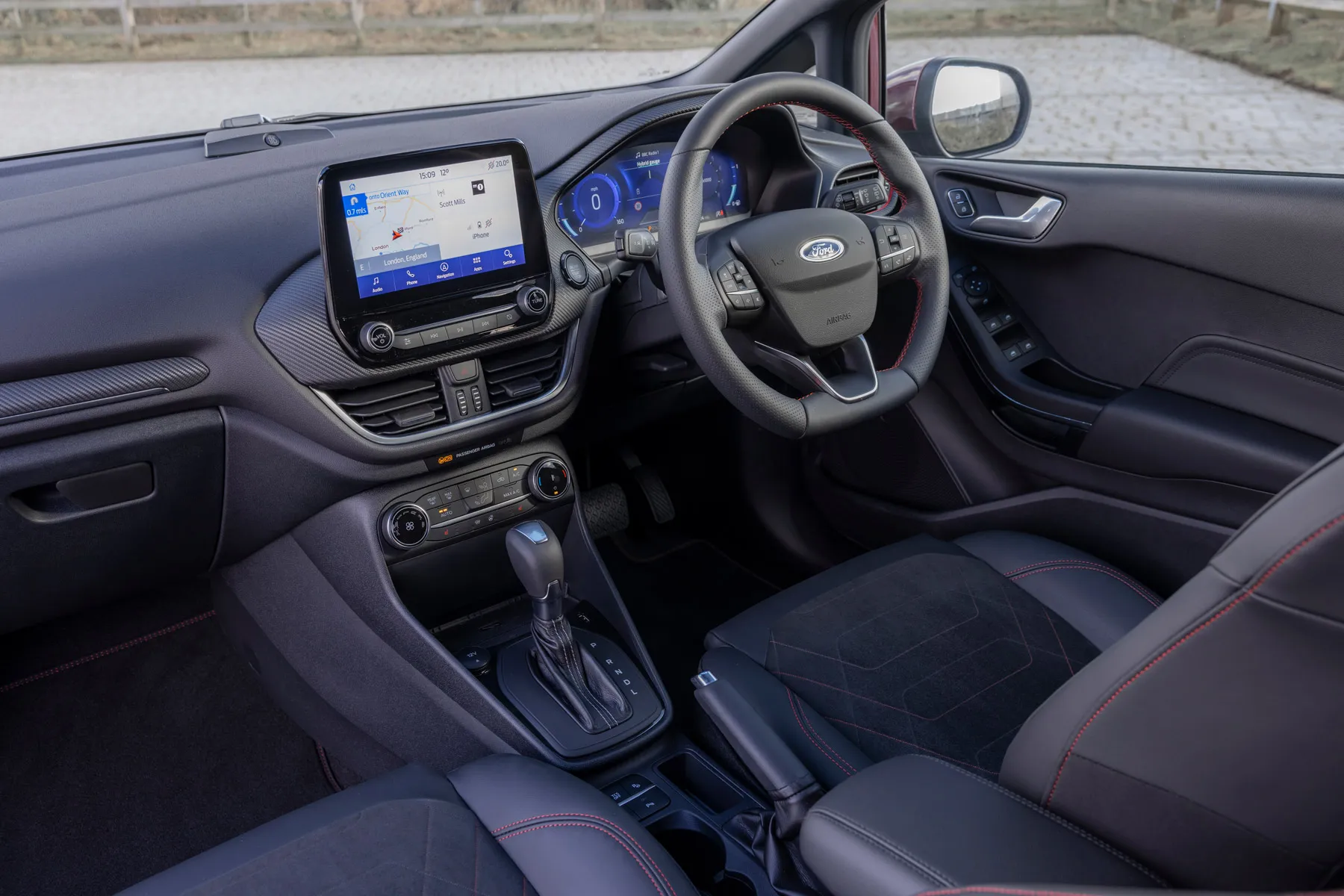
This ‘floating’ display is common to all new Ford Fiesta trim levels, though the better equipped models gain the SYNC 3 version with navigation, voice control and the Ford Pass Connect Wi-Fi connection.
Importantly, this screen is easy to use and to scroll through the various functions for the driver. It’s big enough to read with a quick scan while keeping your attention on the road, too. Another advantage is the touchscreen does away with many of the small buttons for various functions found in the last Fiesta. Even so, the ventilation controls still have too many buttons for our liking – why have two buttons for fan speed when a simple, single rotary dial would work better?
The main dials are easy to see and distinguish on the move and the steering wheel can be altered for angle and depth. Mix this with a comfortable driver’s seat that has height adjustment and you can quickly find the ideal seating position. All is not quite perfect here, though, as the controls for moving the seat are tightly packed between seat base and door, so it’s best to adjust the chair before closing the door. The 2022 update of the Fiesta also brought the option of a 12.3-inch digital dash display that is excellent and can be configured in a number of ways to suit your needs.
The foot pedals are perfectly placed for comfort and easy use, which is something you only really notice when you step into another car and realise how well Ford has managed this.
Quality and finish
This is an area where Ford worked hard to shed the previous Fiesta’s somewhat utilitarian approach to fabrics and materials. It’s a partial success as the upper section of the dash softly padded plastic looks and feels good, while the main sweep of the dash and centre console are just as pleasing. All of the controls work with a pleasingly positive action, particularly the column stalks.
Glance further down and deeper into the cabin of the Ford Fiesta and you begin to notice far more basic looking finished and textures. They are hard-wearing and robust, and Ford put the Fiesta together as well as any of its rivals, but it just misses that last degree of wow factor you get in a MINI or Volkswagen Polo.
This is addressed to some degree in the Vignale model with its upscale trim and appearance. However, there are still some standard Fiesta parts on show in this car. Despite this, the Vignale does impart the feel of a luxury car that has been distilled into a smaller package.
Infotainment: Touchscreen, USB, nav and stereo in the Ford Fiesta
Every Ford Fiesta comes with an infotainment screen of some sort. Basic Trend and Zetec models made do with a 6.5-inch touchscreen, but other trims gained an 8.0-inch display. With the Trend and ST-Line models, you get the SYNC system that comes with a touchscreen and steering wheel buttons. It is easily hooked up to Apple CarPlay or Android Auto for music and apps.
It’s as well you can access apps so readily as this version of the SYNC system is rather basic otherwise, even if it’s much easier to navigate your way through now than Ford’s older versions. The screen is big, bright and has easily prodded icons.
Move into most other Ford Fiesta trims and you get an upgrade to the SYNC 3 infotainment system that includes navigation, voice control and FordPass Connect internet access. Again, this still requires your smartphone to work at its best, but it’s still simple to work.
Both SYNC systems come with Emergency Assistance and DAB radio. Alternatively, you could have the Titanium X or Vignale models with a Bang and Olufsen Premium set-up that has 10 speakers for greater sound quality. This is an option for other trim levels except the base Trend.
From 2022, Ford offered a 12.3-nich digital dash display in place of the standard instrument gauges and it's a great system if you choose a used Fiesta with this fitted.
Space and practicality: Ford Fiesta boot space
The Ford Fiesta is 4040mm long and 1735mm wide, while both the three- and five-door Ford Fiesta models offer exactly the same amount of cabin space. However, the five-door has a clear advantage when it comes to accessing the back seats, which will be a prime consideration for anyone with children. Letting them into the back with the three-door model is simple enough as the front seats tip and slide forwards, but it’s just more of faff than simply opening a rear door.
Once in the back of the Ford Fiesta, there’s a trio of three-point belts and the two outer chairs have ISOFIX kiddy seat mounts. The window line is quite high in the rear of the Fiesta, so younger children may find themselves feeling a bit hemmed in, especially with the standard dark cloth upholstery of most trims.
There’s reasonable space for kids in the back of the Fiesta and it can, at a pinch, take three abreast. For adults, it’s strictly for two and they will find head and leg space at a premium if they are of average or above height.
Turning our attention to load carrying, the Ford Fiesta’s boot has 292-litres of space in normal use, which puts it in the middle ground of this class. It’s deep and uninterrupted by intrusions from the wheel arches, but there is a high load sill to drag heavier bags over.
Extending the load space is simple as the 60/40 split rear seat tips forward when the release levers are pulled. This frees up as much as 1093-litres of space, but it comes with the caveat that its load floor is not flat and has a marked step where the back seat base meets the floor. Nor does the rear bench fold completely horizontal, which hampers its ability to carry bigger boxes home from the DIY shop or cart rubbish to the dump.
Step round to the front cabin of the Ford Fiesta and the driver is well catered for thanks to big door pockets and a centre tray in front of the gear lever. There’s also a lidded cubby between the front seats and a glovebox with enough space to stash a phone charger.
Handling and ride quality: What is the Ford Fiesta like to drive?
"This is an area where the Ford Fiesta has dominated its rivals with panache. While some, like the SEAT Ibiza and Peugeot 208 have closed the gap, the Ford remains the standard for how a small hatch should cover ground and cope with tattered surfaces."
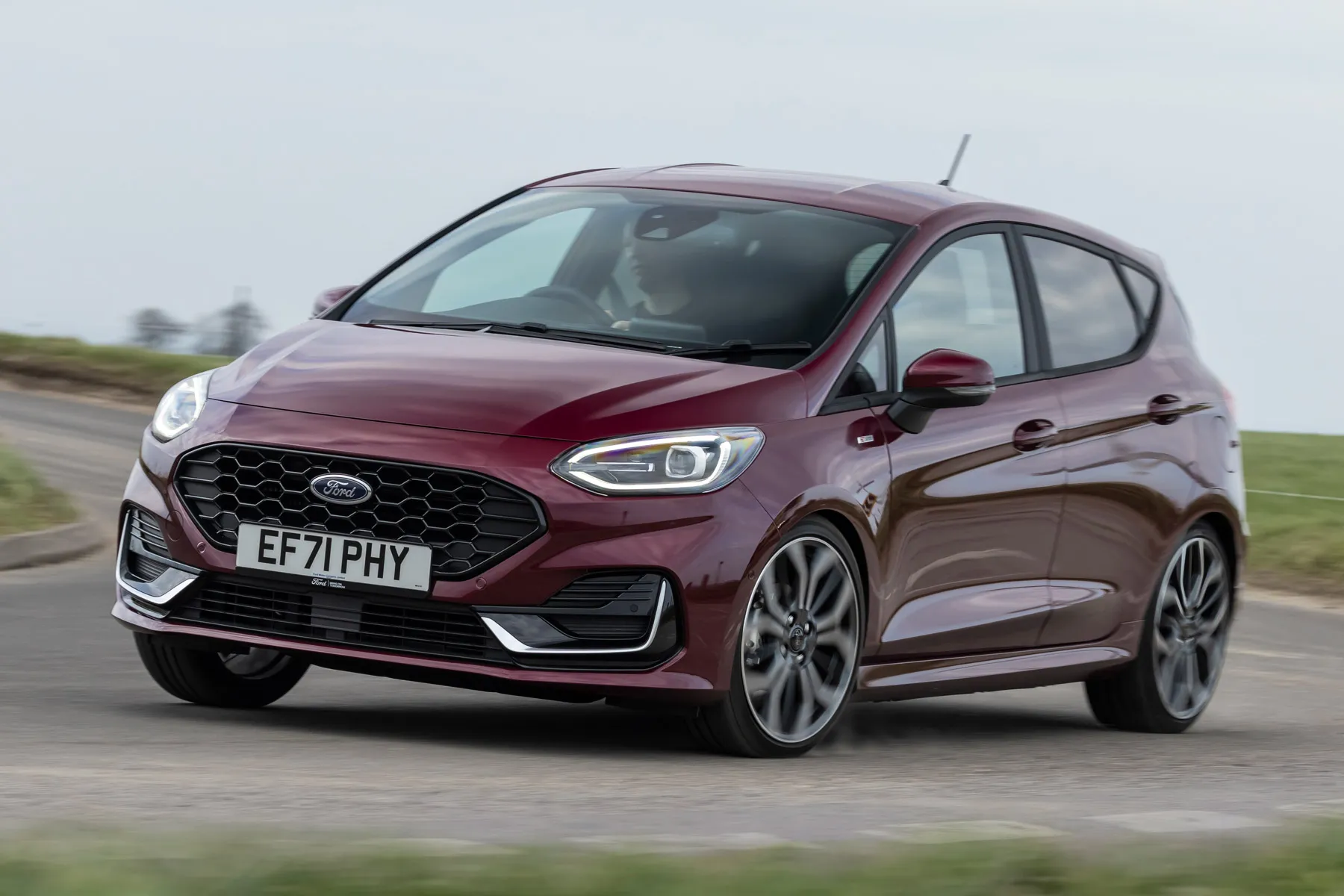
On any type of road, whether in town or motorway, country lane or faster routes, the Ford Fiesta has a knack of flowing along. It does this without any apparent effort, whereas much of the competition will be bouncing around and leaving their occupants feeling less than keen to continue.
As well as its finely controlled suspension, the Fiesta comes with controls for the pedals, gear change and steering that are that little bit better judged for weight and reaction than its rivals. They all combine to give the driver a greater sense of involvement and overall say in how the car behaves that makes it fun, agile and cosseting. It’s also easy to park in packed city streets with a tight turning circle and light power-assisted steering.
Most versions of the Ford Fiesta have the standard suspension set-up. This is ideal for the majority of drivers and situations, but keener drivers might find the ST-Line with its firmer settings is the one to have. It does nothing to undermine the Fiesta’s impressive comfort but curbs body lean and movement along undulating roads to have a sportier edge that many will associate with Ford’s small hatch.
With any Fiesta, motorway driving holds no concerns as the car is stable at high speeds and unfazed by side winds or the blast as you pass lorries. It makes the Ford a great all-round choice in this class and capable of working as your only car as well as a superb second car in a household.
What engines and gearboxes are available in the Ford Fiesta?
The Ford Fiesta line-up started with an entry-level 1.1-litre Ti-VCT petrol engine. We'd recommend avoiding this engine unless you're on a tight budget (or perhaps are a new driver struggling with insurance costs). With a power output of just 85PS, it soon starts to feel out of its depth on the motorway and it's only available with a five-speed manual gearbox.
Far and away the best choice of engine in the Fiesta is the three-cylinder 1.0-litre Ecoboost turbo petrol unit. It was originally offered in 100-, 125- and 140PS outputs and we’d plump for the middle one for its blend of punch, economy, refinement and running costs. All three deliver plenty of low-down pep and are happy to rev hard when required, though you are unlikely to need this as they pull strongly through the standard six-speed manual gearbox. If you want an automatic transmission, this is offered with six gears attached to the 100PS Ecoboost motor. It can be slow to swap gears and is not noted for the smoothness of its shifts, but generally the auto gearbox is inoffensive.
Mild-hybrid tech was added to the Fiesta range in 2020, with a belt-driven starter/generator replacing the standard alternator on 125 and 155PS 1.0-litre EcoBoost models. This isn't a full hybrid, so don't expect huge differences in performance or fuel economy, but it will capture a small amount of energy ordinarily lost under braking. The 100PS engine continued without any hybrid help.
For those covering bigger distances, Ford originally offered the Fiesta with a pair of 1.5-litre turbodiesel engines available in the Fiesta. They are three-cylinder units and can be ordered with 85- or 120PS. It’s a shame there isn’t an option that sits in the middle as the 85PS motor can feel a bit underwhelming at higher speeds while the 120PS unit can feel like overkill. Still, we like the pace of the 120PS turbodiesel and its ability to cruise all day long on the motorway.
Refinement and noise levels
Whichever engine you choose for the Ford Fiesta, and regardless of whether it’s fuelled by petrol or diesel, they are all admirably hushed in town and on the motorway. Even when accelerating hard to join fast moving traffic, the engines have a whizzy, eager feel that makes the driver happy to work them hard.
Road noise is also kept well in the background in every version of the Fiesta even when it’s riding on larger wheels in some of the upscale trims. Although not a criticism as such, we have found the Vignale model to be no quieter than the rest of the range, though this is because of the model’s luxury aspirations rather than any shortfall in its abilities.
Where every Fiesta does pull up short of our expectations is the amount of wind noise that can be heard when driving at higher speeds. It comes from around the windscreen and door mirrors, making a continuous rustle of sound. While not immediately tiring or excessively loud, it does wear after a longer journey and it's something the Volkswagen Polo makes a much better job of filtering out.
Safety equipment: how safe is the Ford Fiesta?
The entire Ford Fiesta range of this generation has six airbags as standard in every model, as well as Ford’s Intelligent Protection System. This is Ford-speak for how the ESP traction control, ABS anti-lock brakes and electronic brake force distribution work together in the event of the car sensing it’s out of shape.
The Fiesta also comes with Hill Start Assist to guard against rolling backwards when pulling away on inclines, while Trailer Sway Control prevents snaking if you’re towing. ISOFIX child seat mounts in the rear seats and a tyre pressure monitoring system complete the standard offering.
Ford offered a number of optional safety packs, including the NCAP Technology Pack that comes with Lane-Keeping Alert and assistance, speed limiter, automatic headlights, and a headrest for the rear middle passenger. Another pack called the Driver Assistance Features brings rain-sensing wipers, Traffic Sign Recognition and Driver Alert with a 4.2-inch colour display in the main instrument pod.
Rear parking sensors were available separately or as part of the City Pack that also provided electrically folding door mirrors with integrated puddle lights. A reversing camera was another option, along with parking assistance and a Blind Spot Information System to warn of cars you might not see in the mirrors.
Ford also offered its MyKey that means different sets of keys to the car can be programmed with individual settings. For instance, a younger driver's key might not let them play the stereo too loudly in case it distracts their attention.
MPG and fuel costs: What does a Ford Fiesta cost to run?
"The Ford Fiesta with the 1.0-litre Ecoboost petrol and mild-hybrid technology with the six-speed manual gearbox returns up to 56.5mpg according to official WLTP fuel economy tests."
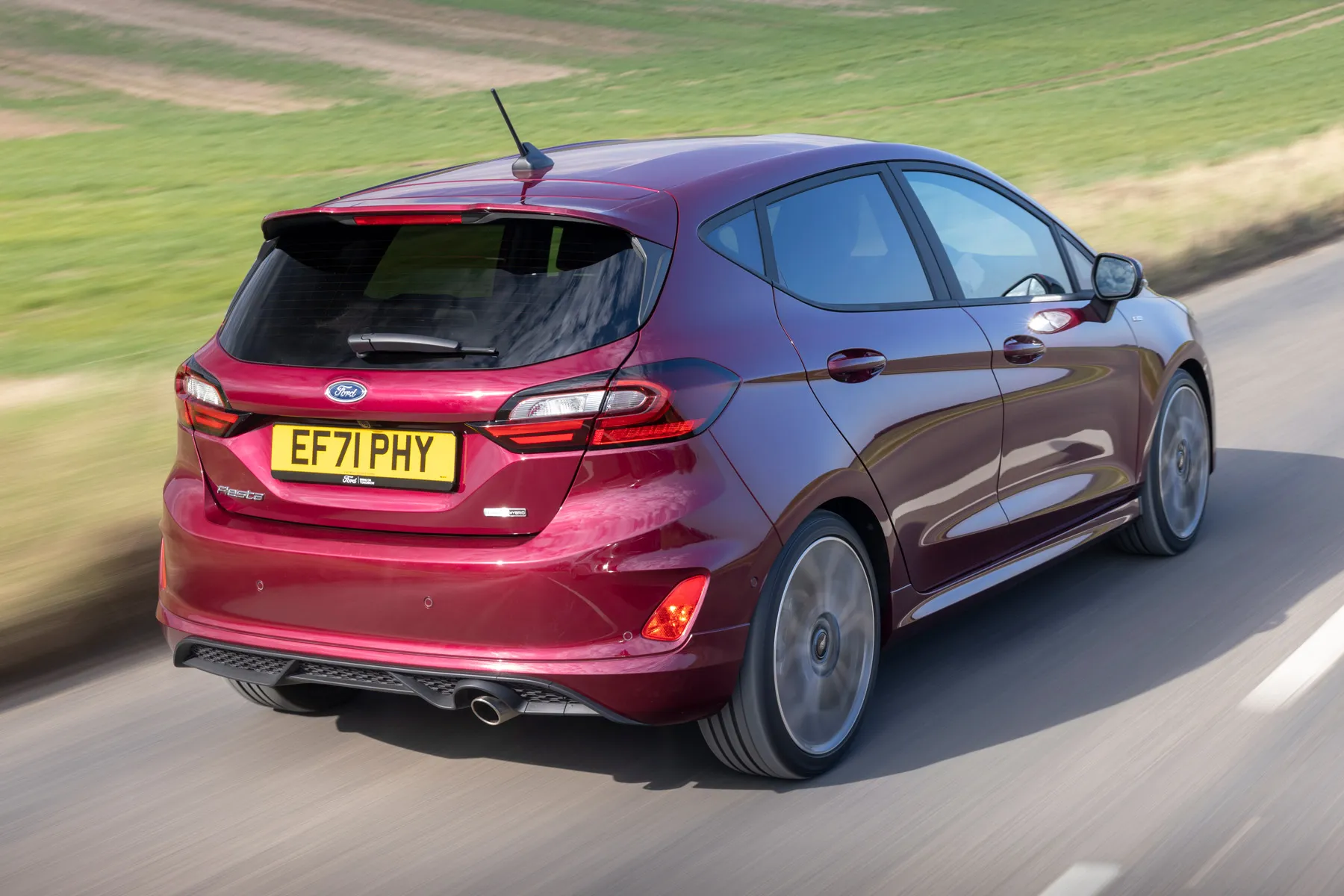
If you buy a Fiesta with the same 1.0-litre mild-hybrid engine and the seven-speed PowerShift automatic gearbox, it could be a little thirstier - officially it'll return up to 53.3mpg. The difference in the real world is likely to be minimal, though, so don't let that sway your decision unless you're going to be really counting the pennies at the pumps.
The Ford Fiesta 1.1-litre petrol will be similarly efficient, officially returning up to 53.3mpg. Being a naturally aspirated (rather than turbocharged) engine might mean it'll return closer to this figure in the real world, but it depends on how hard you work it.
If you cover a lot of miles, look for a Ford Fiesta with the 1.5 TDCi diesel engine. We wouldn't recommend this for regular short journeys or lots of miles around town, but it'll be very frugal on the motorway. Officially it's capable of up to 74.3mpg.
How reliable is the Ford Fiesta?
The Ford Fiesta's long-term reliability appears to be pretty good. There have been a few grumblings over Ford's EcoBoost engines and older PowerShift automatic gearboxes, but any issues seem to have been ironed out by this generation of Fiesta.
Insurance groups and costs
Ford Fiesta insurance gets off to a very affordable start with the 1.1-litre Ti-VCT model that sits in group 5. It’s only available in the lowest Trend specification, but it’s ideal for those just passed their test or parents looking for a second car to share with new drivers.
Our favourite 1.0 Ecoboost turbo petrol-powered models sit in group 10 if you choose the 100PS version of this engine. Move up to the 125PS motor and that hikes up to group 12, or group 13 for the Titanium X and Vignale trims. The 140PS Ecoboost resides in groups 14 or 15 depending on spec, making this Fiesta better suited to those with several years of no claims bonus to their credit. The 155PS engine pushed up as high as group 17. Check out our guide to the cheapest Ford cars to insure for more info.
How much should you be paying for a used Ford Fiesta?
"Early examples of the eight-generation Ford Fiesta can be found from £7000."
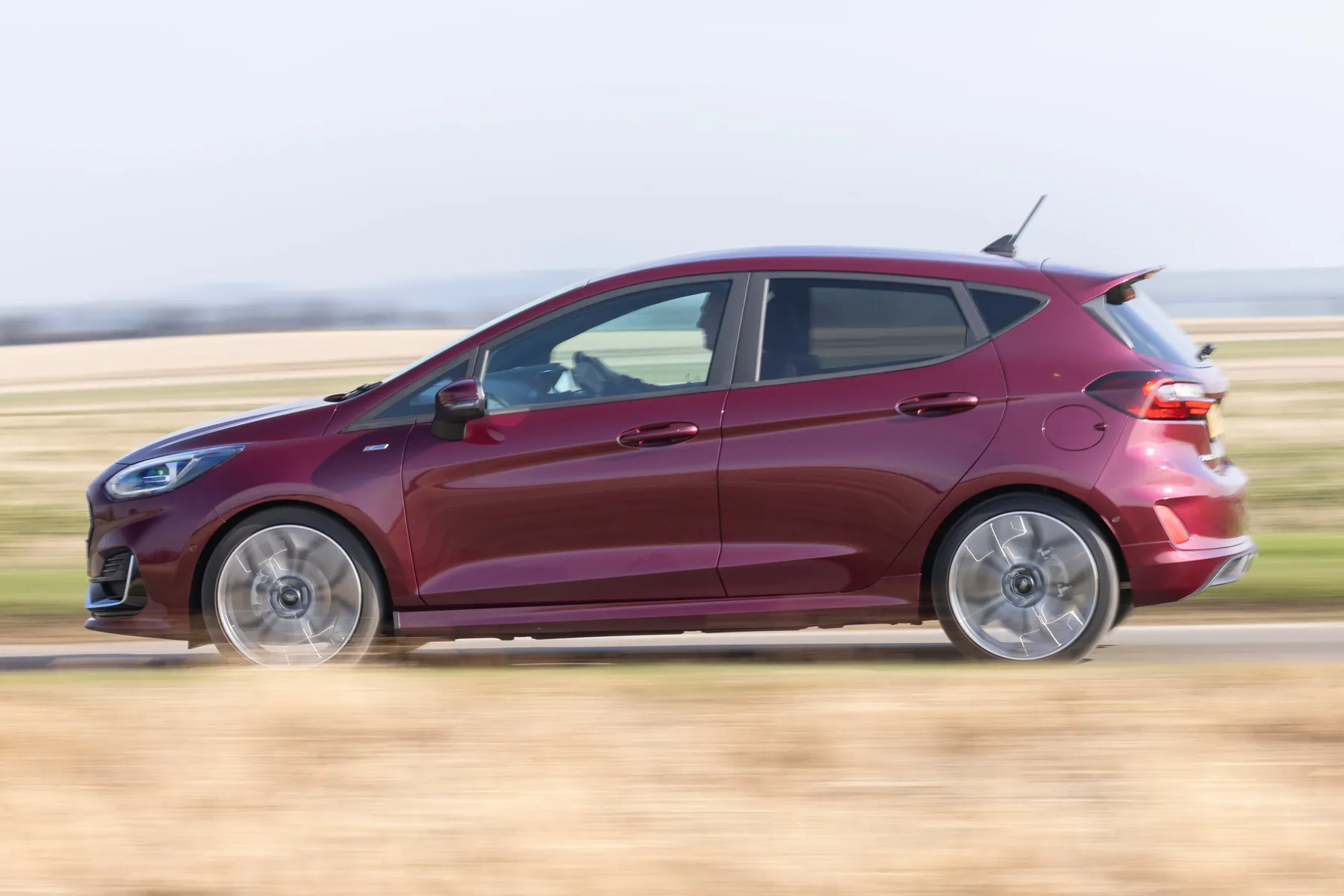
The beauty of buying a Ford Fiesta is there are loads available so you can be really picky about finding the right car for you. Whether it's the trim level, engine or even the colour - don't settle for a Fiesta that's anything less than perfect for your requirements.
The sweet spot in terms of value for money with earlier cars is probably a six-year old Zetec trim with the 1.0-litre EcoBoost petrol engine. This'll cost you around £8000, while a sportier ST-Line model of the same age is only marginally more expensive.
If you're looking for a newer Ford Fiesta, we've seen two-year examples in ST-Line trim with little more for as little as £13,000.
Trim levels and standard equipment
Ford dropped the Fiesta Style and Zetec trims in mid-2019, replacing them with the Trend that then kicked off the range. It comes with 15-inch steel wheels (covered with wheel trims), LED headlights and daytime running lights, a heated windscreen, manual air conditioning and selectable drive modes. An 8.0-inch touchscreen media system is standard (with DAB radio as well as Apple CarPlay and Android Auto) along with a Thatcham alarm system, cruise control (with speed limiter) and a lane-assist feature.
The Ford Fiesta Titanium adds rear privacy glass, keyless start, rear parking sensors, traffic sign recognition and automatic high beam, while the Titanium X builds on this with 17-inch alloy wheels, LED rear lights, automatic climate control, premium seats (with part synthetic leather), heated front seats, a heated steering wheel, keyless entry and a rear-view camera.
The Ford Fiesta Active features a rugged exterior styling kit, rough road suspension (with increased ride height), 17-inch alloy wheels, cloth trim in black/blue with dark blue stitching, cruise control, the eight-inch media system with Apple CarPlay/Android Auto, rear parking sensors and keyless start. The Fiesta Active X adds 18-inch alloy wheels, LED rear lights, automatic climate control, heated front seats and steering wheel and a rear-view camera.
The sportier Ford Fiesta ST-Line comes with 17-inch alloy wheels, LED headlights, rear privacy glass, a bespoke body styling kit, sports suspension, selectable drive modes, manual air con and the eight-inch touchscreen infotainment system. The seats are trimmed in cloth with red stitching, while driver-assistance tech includes cruise control, rear parking sensors, traffic sign recognition and lane-keep assist.
The Ford Fiesta ST-Line X comes with 18-inch alloy wheels, LED rear lights, automatic climate control, premium seats (with part synthetic leather), heated front seats and a heated steering wheel. Keyless entry and start are standard, as well as a rear-view camera.
The luxurious Vignale trim offered its own exterior styling for the grille, bumpers, and front fog lights, as well as 17-inch alloy wheels. It also came with a panoramic glass sunroof, quilted leather, heated front seats, and reversing camera.
Ask the heycar experts: common questions
Is the Ford Fiesta a good car?
What's wrong with the Ford Fiesta?
Why did Ford discontinue the Fiesta?
Get our latest advice, news and offers
Keep me updated by email with the latest advice, news and offers from heycar.
By submitting you agree to our privacy policy
